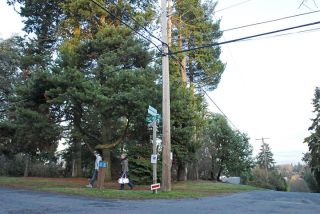City Councilmembers want more input from the community about what to do with vacant land on First Hill.
The nearly three-quarter acre lot is on the northeast corner of S.E. 32nd Street and 74th Avenue S.E.
Councilmembers postponed declaring the city-owned property a surplus by narrowly tabling a motion to declare the property a surplus. The action allows the city to discuss all possible changes to the property, which include selling it, keeping it as a park or constructing a demonstrative subsidized housing community. Other options could be keeping the status quo or selling the property and using the money to fund the emergency well at Rotary Park.
“We need to figure out what we’re doing with the property before we move forward with surplusing it,” Councilmember Steve Litzow said. “We can make the procedural decision to surplus the property at any time later on. First, we need to make sure we do all our homework and talk with the neighbors.”
State law allows cities to declare lands acquired for public utility purposes to be labeled a surplus and be leased or sold. Before doing so, however, a city must hold a public hearing, determine the fair market value, rent, other considerations to be paid and other terms and conditions governing the disposition of the property.
The private market value of the property has not yet been determined but the city will be required if and when the Council declares the property a surplus.
In order to create a demonstrative subsidized housing community, the Council would have to create in interim ordinance to allow such a development in a single family housing zone. That move would set a precedent that worries some neighbors.
“My daughter wishes that I advise you on her behalf to keep [the property] as open space,” said Tedd Misselwitz, an Islander whose daughter lives near the property. “But if you decided not to, we both favor single family as it is currently zoned. We are opposed to any re-zone.”
The lot is on north the east corner of the intersection of 32nd and 74th. It has partial views of the Cascades and downtown Bellevue. Today, it is used as an open space, often used by children sledding in the snow this time of year or taking the dog to play fetch.
Legally, the lot could be subdivided into three single-family lots. The county assessors office list the value as $700,000. During the Council meeting, the neighborhood residents expressed support to keep it as a park but differed on what should be done if changes are to be made. Some said they supported the subsidized community, fearing the addition of more mega-homes if other developments were made.
“Single family homes on single lots have done more damage to neighborhood,” said Anne Fox, who lives on the corner to the west. “The demonstration project would create more of a neighborhood feel than mega-houses that have been going in.”
Not all residents liked the idea of the subsidized housing, however. Misselwitz said he and his daughter, who lives across the street from the property, are opposed to a re-zone because it would change the neighborhood’s character.
“There is plenty of affordable housing in the condos around there and Shorewood,” Misselwitz also said. “The demonstration project rises concerns of congestion.”
The property was originally acquired by the Island’s water district and later by the city upon incorporation. County property records show a home was built there in 1953, which was torn down in 2006.
Last summer, the city’s Utility Board unanimously recommended the Council “declare the property a surplus” and that it be sold with “the proceeds of the sale to be used by the Water Utility.”
Before the regular meeting last Monday, a study session took place between Councilmembers, city staff, and a housing consultant to discuss the city’s options. Much of the focus was on Arthur Sullivan, a representative of ARCH, an organization created by Eastside cities to provide low-to-moderate income housing.
The demonstrative housing project would allow the city to explore the feasibility of addressing changing demographics on Mercer Island. The city’s comprehensive plan states that city-owned property no longer required for its purposes should be evaluated for its suitability for affordable housing.
During the study session, Sullivan said the design features of the community would be reflective of the neighboring properties, with homes set back from streets, private open spaces for residences, unified building materials and well defined entries.
“We were looking for and exploring mixing various forms of housing. Things you think of when you think of single family homes,” Sullivan said.
Keeping it as an open space would require the city to transfer the value of the land to its water utility fund.
Susan Madison, an Island resident who lives several blocks away to the west, stated she supported the demonstration project but urged the Council to be diligent in its decision making.
“Does the Council have resources to monitor intense planning?” she asked. “You have to determine if you are hitting your target market or allowing somebody to get a great deal on some property.”
Councilmembers Mike Grady, Jahncke and Deputy Mayor Jim Pearman dissented in the 4-3 vote to table the motion.
“We currently have some higher public policy goals that I think we need to pursue,” Jahncke said. “Those are affordability, density, diversity and, I guess, sustainability. This is an opportunity to do that.”


